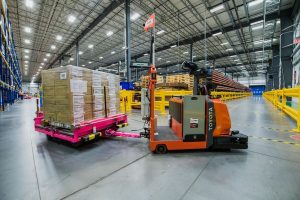Designing the Ideal Warehouse: A Blueprint for Efficiency and Success
Warehouses play a pivotal role in the supply chain, serving as the nerve center for the storage, handling, and distribution of goods. A well-designed warehouse can significantly impact the overall efficiency of a business, affecting everything from inventory management to customer satisfaction. In this article, we will explore the key components that make up a good warehouse and discuss the strategies for optimizing its layout and operations. What does a good warehouse look like?
The Foundation: Strategic Location and Accessibility
The first step in creating an effective warehouse is selecting the right location. Proximity to suppliers, transportation hubs, and target markets is crucial for reducing transportation costs and ensuring timely deliveries. Accessibility for trucks and other vehicles is equally important, as it streamlines the inbound and outbound logistics processes. A good warehouse is strategically positioned to minimize transit times and enhance overall supply chain agility.
Optimal Layout and Space Utilization
Once the location is secured, the layout of the warehouse becomes paramount. A well-organized warehouse maximizes space utilization and minimizes travel time for both employees and machinery. The layout should be designed to accommodate the specific needs of the products being stored, considering factors such as size, weight, and storage requirements.
Key considerations for an optimal layout include the implementation of a systematic racking system, efficient shelving units, and clear aisle markings. Automated storage and retrieval systems (AS/RS) can further enhance space utilization by utilizing vertical space effectively. This not only saves on floor space but also improves overall accessibility and order fulfillment speed.
Technology Integration for Enhanced Efficiency
In the modern era, technology plays a crucial role in warehouse management. Integrating warehouse management systems (WMS), barcode scanners, and RFID technology can significantly enhance efficiency and accuracy. A good warehouse is equipped with the latest technological solutions to streamline processes, track inventory in real-time, and reduce human errors.

Automation for Speed and Precision
Automation is a game-changer in warehouse operations. Automated guided vehicles (AGVs), conveyor systems, and robotic picking systems can drastically reduce the time and effort required for tasks such as picking, packing, and shipping. Implementing automation not only improves efficiency but also minimizes the risk of errors, resulting in higher customer satisfaction and cost savings in the long run.
Employee Training and Safety Measures
While technology is crucial, a good warehouse recognizes the importance of a well-trained and motivated workforce. Employee training programs should be in place to ensure that staff is familiar with the latest technologies and safety protocols. This not only enhances productivity but also reduces the likelihood of accidents and injuries.
Safe and Ergonomic Work Environment
Safety should be a top priority in any warehouse. A good warehouse is designed with safety in mind, implementing measures such as proper lighting, non-slip flooring, and clear signage. Additionally, ergonomic workstations and equipment contribute to employee well-being, reducing the risk of injuries and improving overall job satisfaction.
Real-Time Visibility and Analytics
To stay ahead in today’s fast-paced business environment, a good warehouse relies on real-time visibility into its operations. Advanced analytics tools provide insights into inventory levels, order fulfillment rates, and overall warehouse performance. This data-driven approach enables proactive decision-making, helping warehouses adapt to changing market conditions and customer demands.
Scalability for Future Growth
An effective warehouse is designed with scalability in mind. As businesses grow, warehouse operations must be able to adapt seamlessly to increased demand and a larger inventory. Scalability ensures that the warehouse can handle higher volumes without sacrificing efficiency or incurring significant additional costs.
Sustainability and Environmental Considerations
In the era of corporate responsibility, a good warehouse incorporates sustainable practices into its operations. This includes energy-efficient lighting, waste reduction strategies, and eco-friendly packaging materials. Adopting environmentally friendly practices not only aligns with corporate values but can also result in cost savings and positive brand image.

Collaboration and Integration with Partners
A well-functioning warehouse is not an isolated entity; it is an integral part of the broader supply chain. Collaborating with suppliers, distributors, and other partners is essential for seamless operations. Integration with external systems and open communication channels facilitate real-time information exchange, enabling all stakeholders to work together towards common goals. For c & g coolrooms warehouses read this.
Conclusion: The Blueprint for Success
In conclusion, a good warehouse is the result of careful planning, strategic decision-making, and the integration of advanced technologies. From its location and layout to the implementation of automation and employee training, each element plays a crucial role in optimizing warehouse efficiency. By focusing on these key components and embracing innovation, businesses can create a warehouse that not only meets current needs but is also poised for future growth and success in the dynamic world of logistics and supply chain management. What does a good warehouse look like?

Recent Comments